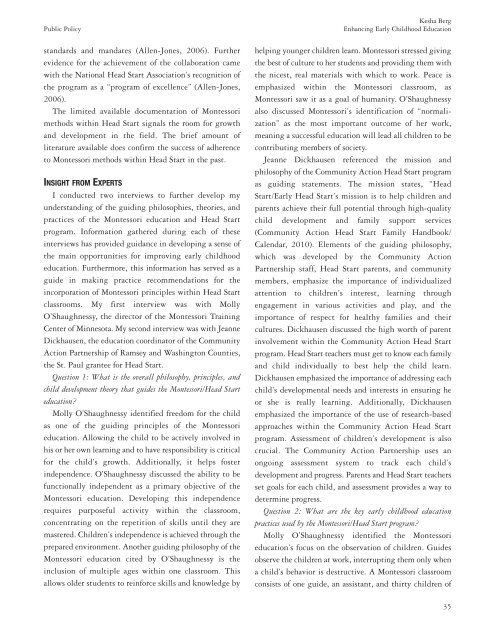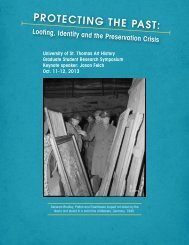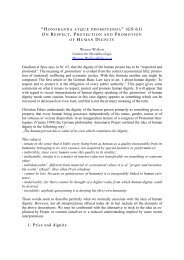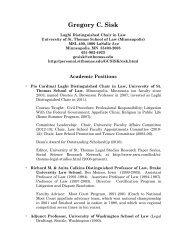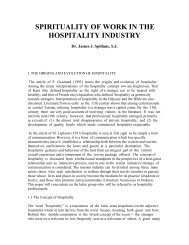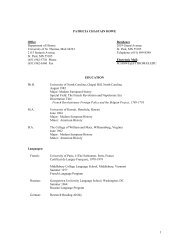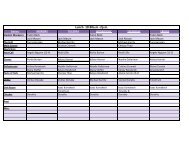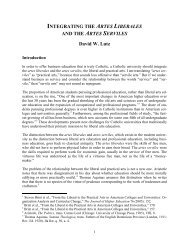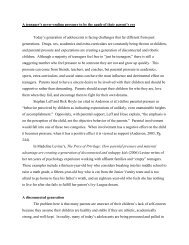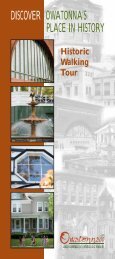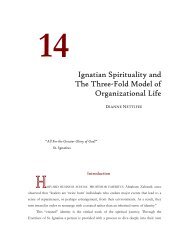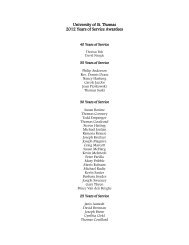dr. ronald e. mcnair acknowledgements - University of St. Thomas
dr. ronald e. mcnair acknowledgements - University of St. Thomas
dr. ronald e. mcnair acknowledgements - University of St. Thomas
You also want an ePaper? Increase the reach of your titles
YUMPU automatically turns print PDFs into web optimized ePapers that Google loves.
Kesha Berg<br />
Public Policy Enhancing Early Childhood Education<br />
standards and mandates (Allen-Jones, 2006). Further<br />
evidence for the achievement <strong>of</strong> the collaboration came<br />
with the National Head <strong>St</strong>art Association’s recognition <strong>of</strong><br />
the program as a “program <strong>of</strong> excellence” (Allen-Jones,<br />
2006).<br />
The limited available documentation <strong>of</strong> Montessori<br />
methods within Head <strong>St</strong>art signals the room for growth<br />
and development in the field. The brief amount <strong>of</strong><br />
literature available does confirm the success <strong>of</strong> adherence<br />
to Montessori methods within Head <strong>St</strong>art in the past.<br />
INSIGHT FROM EXPERTS<br />
I conducted two interviews to further develop my<br />
understanding <strong>of</strong> the guiding philosophies, theories, and<br />
practices <strong>of</strong> the Montessori education and Head <strong>St</strong>art<br />
program. Information gathered during each <strong>of</strong> these<br />
interviews has provided guidance in developing a sense <strong>of</strong><br />
the main opportunities for improving early childhood<br />
education. Furthermore, this information has served as a<br />
guide in making practice recommendations for the<br />
incorporation <strong>of</strong> Montessori principles within Head <strong>St</strong>art<br />
classrooms. My first interview was with Molly<br />
O’Shaughnessy, the director <strong>of</strong> the Montessori Training<br />
Center <strong>of</strong> Minnesota. My second interview was with Jeanne<br />
Dickhausen, the education coordinator <strong>of</strong> the Community<br />
Action Partnership <strong>of</strong> Ramsey and Washington Counties,<br />
the <strong>St</strong>. Paul grantee for Head <strong>St</strong>art.<br />
Question 1: What is the overall philosophy, principles, and<br />
child development theory that guides the Montessori/Head <strong>St</strong>art<br />
education?<br />
Molly O’Shaughnessy identified freedom for the child<br />
as one <strong>of</strong> the guiding principles <strong>of</strong> the Montessori<br />
education. Allowing the child to be actively involved in<br />
his or her own learning and to have responsibility is critical<br />
for the child’s growth. Additionally, it helps foster<br />
independence. O’Shaughnessy discussed the ability to be<br />
functionally independent as a primary objective <strong>of</strong> the<br />
Montessori education. Developing this independence<br />
requires purposeful activity within the classroom,<br />
concentrating on the repetition <strong>of</strong> skills until they are<br />
mastered. Chil<strong>dr</strong>en’s independence is achieved through the<br />
prepared environment. Another guiding philosophy <strong>of</strong> the<br />
Montessori education cited by O’Shaughnessy is the<br />
inclusion <strong>of</strong> multiple ages within one classroom. This<br />
allows older students to reinforce skills and knowledge by<br />
helping younger chil<strong>dr</strong>en learn. Montessori stressed giving<br />
the best <strong>of</strong> culture to her students and providing them with<br />
the nicest, real materials with which to work. Peace is<br />
emphasized within the Montessori classroom, as<br />
Montessori saw it as a goal <strong>of</strong> humanity. O’Shaughnessy<br />
also discussed Montessori’s identification <strong>of</strong> “normali -<br />
zation” as the most important outcome <strong>of</strong> her work,<br />
meaning a successful education will lead all chil<strong>dr</strong>en to be<br />
contributing members <strong>of</strong> society.<br />
Jeanne Dickhausen referenced the mission and<br />
philosophy <strong>of</strong> the Community Action Head <strong>St</strong>art program<br />
as guiding statements. The mission states, “Head<br />
<strong>St</strong>art/Early Head <strong>St</strong>art’s mission is to help chil<strong>dr</strong>en and<br />
parents achieve their full potential through high-quality<br />
child development and family support services<br />
(Community Action Head <strong>St</strong>art Family Handbook/<br />
Calendar, 2010). Elements <strong>of</strong> the guiding philosophy,<br />
which was developed by the Community Action<br />
Partnership staff, Head <strong>St</strong>art parents, and community<br />
members, emphasize the importance <strong>of</strong> individualized<br />
attention to chil<strong>dr</strong>en’s interest, learning through<br />
engagement in various activities and play, and the<br />
importance <strong>of</strong> respect for healthy families and their<br />
cultures. Dickhausen discussed the high worth <strong>of</strong> parent<br />
involvement within the Community Action Head <strong>St</strong>art<br />
program. Head <strong>St</strong>art teachers must get to know each family<br />
and child individually to best help the child learn.<br />
Dickhausen emphasized the importance <strong>of</strong> ad<strong>dr</strong>essing each<br />
child’s developmental needs and interests in ensuring he<br />
or she is really learning. Additionally, Dickhausen<br />
emphasized the importance <strong>of</strong> the use <strong>of</strong> research-based<br />
approaches within the Community Action Head <strong>St</strong>art<br />
program. Assessment <strong>of</strong> chil<strong>dr</strong>en’s development is also<br />
crucial. The Community Action Partnership uses an<br />
ongoing assessment system to track each child’s<br />
development and progress. Parents and Head <strong>St</strong>art teachers<br />
set goals for each child, and assessment provides a way to<br />
determine progress.<br />
Question 2: What are the key early childhood education<br />
practices used by the Montessori/Head <strong>St</strong>art program?<br />
Molly O’Shaughnessy identified the Montessori<br />
education’s focus on the observation <strong>of</strong> chil<strong>dr</strong>en. Guides<br />
observe the chil<strong>dr</strong>en at work, interrupting them only when<br />
a child’s behavior is destructive. A Montessori classroom<br />
consists <strong>of</strong> one guide, an assistant, and thirty chil<strong>dr</strong>en <strong>of</strong><br />
35


